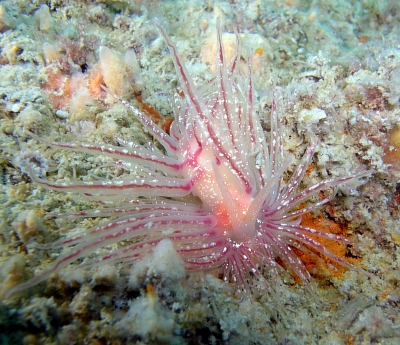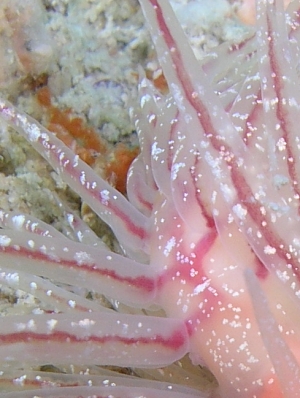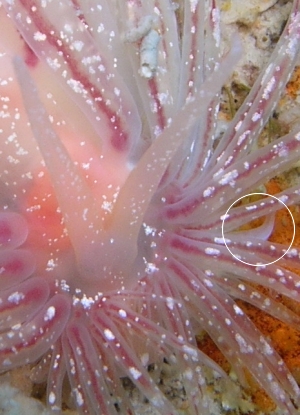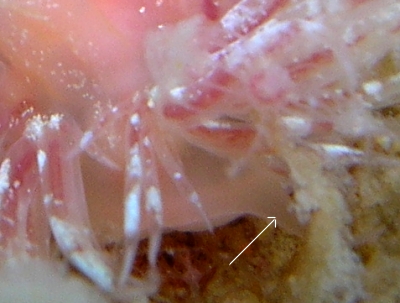Re: Cumanotus beaumonti from Italy
May 11, 2006
From: Cristian Magnani

Concerning message #16466:
Dear Bill
I wish to add some more information about my Cumanotus in order to get a better knowledge of this wonderful animal. In my earlier message I've written it was 3 cm but I would say it was bigger in size, reaching at least 4 cm.
Secondly, when I moved a specimen to get a better picture I remember now that it actively swam by waving its body and cerata [see message #16580]. It also releases some of its cerata in autotomy when touched.
On that occasion I saw two small oral tentacles on the head. You can see them in a pair of attached pictures, being white in color while the cerata are more pinkish. Please note also that the red pattern on the back is very similar to the one in Marina Poddubetskaia's photos of Cumanotus cuenoti.
I've emailed Dr. Massimo Ponti who works at a research project on this restricted diving area and he wasn't able to confirm the hydroid was E. dumortieri, so i do agree with your guess about Tubularia. Of one thing I am sure - there are no solitary hydroids on the sunken rig, simply the mud cover on the structure is too thin to allow the growth of this kind of hydroid
I wish also to say that the dive area where I spotted this nudibranch is only 150 km from Capo Piran, Slovenia, where it was previously seen [message #13477]. I hope this further information may be helpful.
Locality: Paguro Shipwreck, 20, Italy, Adriatic sea, 25 April 2006, wreck. Length: 4 cm. Photographer: Cristian Magnani.
Thanks again
Best wishes
Cristian
info@nudibranchi.it
info@nudibranchi.it



Dear Cristian,
The extra information has certainly confirmed your animal to be C. beaumonti as that is the only species with oral tentacles and tentacle-like extensions on the anterior corners of the foot. The middle right photo shows what could either be an oral tentacle or a tentacular foot corner, and the lower right photo clearly shows an oral tentacle. The colour pattern on the back you mention as being the same as in Marina's photos is caused by the coloured contents of the ducts which run back from the stomach to each of the cerata. The reddish core up the middle of each ceras is the digestive gland, which in molluscs is the part of the body which produces the digestive juices and absorbs the food - a mixture of our liver and intestine.
What would be very interesting would be to find some small animals on your shipwreck, or even in the general area. It would be nice to know if juveniles have oral tentacles or not. If they do not, then C. cuenoti, which is characterised by the lack of oral tentacles, could be just a juvenile of C. beaumonti. The other alternative is for Marina to keep a watch out for the next appearance of her C. cuenoti population and see if they stay small sized or grow much larger. If they grew larger and grew tentacles then I would say there is little doubt that C. beaumonti and C. cuenoti are the same species.
Best wishes,
Bill Rudman
Related messages
-
Cumanotus beaumonti feeds on Tubularia
From: Dominique Horst, April 21, 2010 -
Cumanotus beaumonti burrowing and swimming
From: Dominique Horst, April 20, 2010 -
Cumanotus beaumonti - reproduction
From: Dominique Horst, April 20, 2010 -
Cumanotus beaumonti feeding
From: Dominique HORST, April 20, 2010 -
Cumanotus beaumonti from the French Mediteranean
From: Dominique Horst, April 20, 2010 -
Re: Cumanotus from Slovenia [2]
From: Sandrine Bielecki, February 25, 2009 -
Re: Cumanotus beaumonti and C. cuenoti
From: Cristian Magnani, May 13, 2006 -
Cumanotus beaumonti swimming
From: Cristian Magnani, May 11, 2006 -
Re: Cumanotus beaumonti from Italy
From: Philip Cromwell, May 10, 2006 -
Cumanotus beaumonti from Italy
From: Cristian Magnani, May 10, 2006 -
Cumanotus from Slovenia [2]
From: Tom Turk, April 13, 2005 -
Re: Cumanotus from Slovenia
From: Tom Turk, April 12, 2005 -
Cumanotus from Slovenia
From: Tom Turk, April 11, 2005
